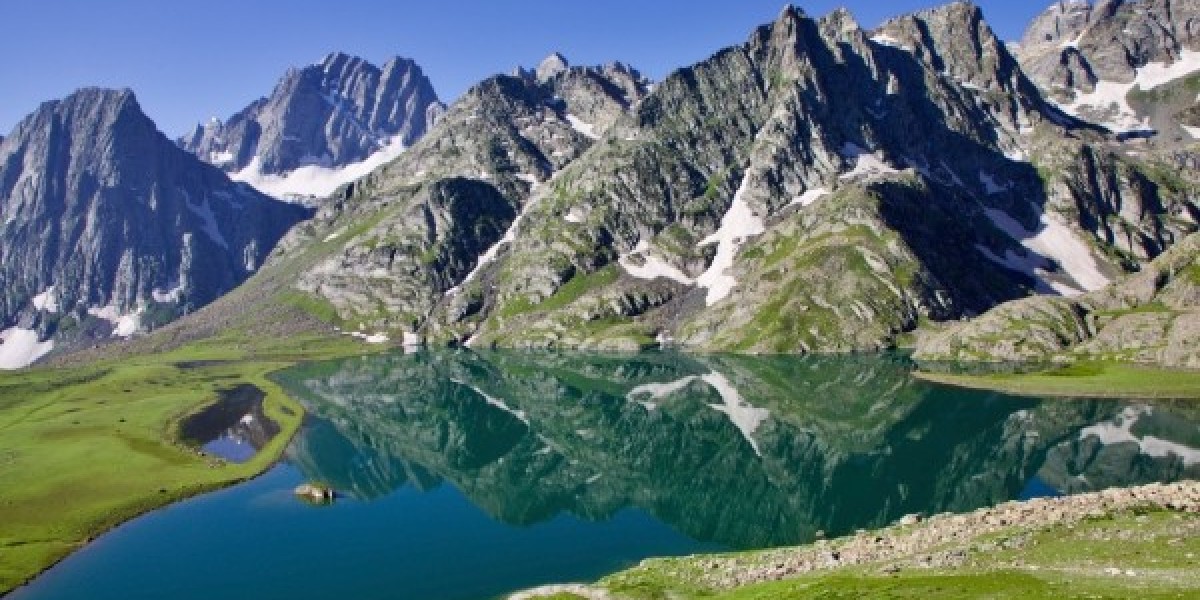Kashmir Great Lakes trek is widely accepted as one of the most stunning facades of the Himalayas as has ever been witnessed. Between alpine lakes encircled by snow-capped mountains and meadows overflowing with wild flowers, lies the impressive view. However, along with the wondrous scenery, there are difficulties that come with the Kashmir trekking. It’s not the kind of Himalayan adventure one can undertake magically; proper planning and logistics are needed due to high altitude, mixed weather and difficult topography.
In this post, we will present you with seven crucial strategies that will equip you for this wonderful terra incognita. My motivation is to focus this post on various aspects of trekking which include physical fitness, meditation, selection of equipment, safety procedures, etc.
Getting Ready Physically For High Altitude Mountaineering
A knowledgeable guide will be able to tell you that there are two key determinants of whether you will either struggle or succeed on the Kashmir Great Lakes trek: one of those is your mindset and the other is physical preparation. At higher altitudes, your body has to function under the intake of lesser oxygen, highlighting the importance of physical fitness before every adventure.
Building Cardiovascular Endurance
Due to the low density of oxygen in high altitudes, your body metabolism is forced to adapt which translates into your breathing rate increasing up to 40-60 breaths per minute when an individual indulges in any activity. Preparations for the trek should commence at least two months prior to the event to enable your body to adjust to the conditions. Our assessment indicates that individuals under 40 years of age should aim to complete a distance of 5 km in approximately 30 to 32 minutes, while those aged 40 and above should target a completion time of 32 to 35 minutes.
Strength Development Exercises
You really have to combine strong legs with a solid core in order to have a good time on the trails. Here’s
Squats: Start with 2 sets of 12 repetitions
Lunges: Focus on knee-muscle coordination
Planks: Build core stability for backpack carrying
Hip raises: Improve mobility for steep sections
Altitude Acclimatization Tips
Proper acclimatization matters at the significant heights of the Kashmir Great Lakes trek. The "climb high, sleep low" principle guides our approach - you can trek safely up to 2,700-3,000 meters without acclimatizing. Beyond that, increase your sleeping altitude by only 300-400 meters daily.
Your body loses water faster through increased breathing at higher elevations, so drink 3-4 liters of water daily at altitude. Keep a steady pace where conversation flows easily - if you can't sing while hiking, slow down.
Essential Gear and Packing Strategy
Now that you have some expertise in physical preparation, Singapore Great Lakes trekking gear is worth a discussion. Indeed, we have learned from experience that appropriate equipment can at times make all the difference between success or failure during your adventure in the Himalayas.
Weather-appropriate Clothing Layers
The right layering system ensures comfort in mountain weather. Here's what you need:
Base layer: Moisture-wicking thermal tops and bottoms
Mid layer: Fleece jacket and trekking pants
Outer layer: Waterproof jacket and pants with ankle zips
Accessories: UV-protected sunglasses, warm beanie, and waterproof gloves
Critical Safety Equipment
Your safety matters most on every trek. You need a backpack with a 50-60 liters capacity that contains these vital items:
A reliable headlamp with 100+ lumens output
First aid kit with altitude sickness medication
Emergency shelter or bivy sack
Two water bottles (1-liter each)
Smart Packing Techniques
Our three-part packing system has worked well on countless treks. Light gear goes at the bottom, heavy items sit in the middle close to your back, and frequently needed items stay at the top. This arrangement helps you balance better on steep terrain.
Waterproof stuff sacks work best to organize your gear. Your sleeping bag and spare clothes belong in the bottom section, food, and cooking gear go in the middle, and safety equipment stays easily available at the top or in external pockets.
Note that trekking poles should attach to your pack's side when not in use - you'll need them for stability on the varied terrain of the Kashmir Great Lakes trek.
Navigation and Safety Protocols
Smart navigation leads to trail safety, and over the last several years of leading the Kashmir Great Lakes trek, we have mastered these vital protocols. Let me share what we've learned about staying safe in these magnificent but challenging Himalayan terrains.
Understanding Trail Markers
Several marker types guide our way on the trail. These are the signs we look for:
Paint blazes on trees and rocks at eye level
Cairns (rock piles) in areas above the treeline
Metal or wooden markers attached to trees
Emergency markers with specific location codes
Emergency Response Plans
Regular check-ins at army camps along the route from our safety strategy. The Gadsar army camp's documentation process takes 2-3 hours to verify original identification cards. The Naranag checkpost closes at 4 PM sharp, so we plan our return time.
Communication Methods
Multiple channels help us maintain reliable communication. Our team uses satellite phones where conventional coverage doesn't exist. Mobile networks (NTC and Ncell) work well in lower regions like Lukla and Namche Bazaar, though higher elevations have spotty connectivity.
Voice commands and hand signals help coordinate our groups. Clear, loud calls work best in good visibility, and we direct them toward the other person. Our backup radio system becomes essential in challenging conditions or busy areas. It operates on the 446 MHz frequency and provides a range of about 5 km in open terrain.
The army's guidance determines our response to security concerns. Experience has taught us to stop all movements during disturbances and wait for the green signal from nearby CRPF checkposts before moving forward.
Mental and Emotional Readiness
Our decade of leading treks has taught us something surprising. Mental strength plays a bigger role than physical fitness on the Kashmir Great Lakes trek. Studies reveal that trek success depends 80% on mental preparation and only 20% on physical readiness.
Developing Trek Mindset
The right mindset begins with good preparation. You should know your route, highest altitude points, camps, terrain, and trail maps before you start. Knowledge truly is the difference between a safe trek and a dangerous one. Our trekkers see great results when they practice visualization techniques. They create vivid mental images of completing challenging sections.
Managing Altitude Anxiety
Altitude-related anxiety happens to everyone - it's perfectly normal. Here's what works best to handle it:
Practice deep breathing exercises when you feel overwhelmed
Break the trek into smaller, achievable goals
Keep your progress steady instead of rushing
Talk openly with trek leaders about your concerns
Note that altitude sickness symptoms usually show up within the first day at high elevation. Quick recognition of these symptoms and taking the right action prevent most complications.
Team Bonding Strategies
Good team dynamics can make your trek exceptional. Research shows that 89% of trekkers say positive relationships improve their overall experience by a lot. escape2explore help build team bonds through:
Shared Goals: Everyone faces the same challenges, which creates natural empathy and support
Extended Bonding Time: Multi-day treks build deeper connections than traditional team activities
Natural Settings: The outdoors breaks down social barriers and hierarchies
Teams that bond well tackle challenges more effectively and support each other through tough sections. This spirit of working together, rather than competing, makes the trail safer and more enjoyable.
Key Takeaways
The Kashmir Great Lakes trek just needs full preparation in physical fitness, proper gear, safety awareness, and mental readiness. Our unique experience with countless trekkers through this magnificent landscape shows that success comes from paying attention to these elements.
Proper physical training and acclimatization techniques are key factors in whether you will struggle or excel at high altitudes. Thoughtful packing methods and selecting the right equipment ensure that trekkers remain safe and comfortable as weather conditions shift. Effective navigation strategies, combined with strong mental readiness, can transform difficult moments into fulfilling accomplishments.
I believe that the charm of this journey is not limited to the fact that you come across seven beautiful alpine lakes, but rather it fosters self development as well. Combating obstacles takes a keen insight and a well formed plan, as each person possesses attributes they were not aware of. Adopting these suggestions will also enhance your chance of making it through successfully while experiencing, in my opinion, one of the most beautiful treks in the Himalayas.
FAQs
Is the Kashmir Great Lakes Trek Difficult?
Generally speaking, the Kashmir Great Lakes Trek is rated as an intermediate level challenge. Being a traveler undertaking such a journey has its fair share of difficulties as one has to go through rocky terrains, meadows and ridges. In some places, there will be a fair bit of rising and dropping. Appropriate physical training and acclimatization will make a difference to the enjoyment of the experience.
What measures are to be taken in order to prepare my body for the Kashmir Great Lakes Trek?
Start training at least two months prior to the trek. You should be able to cover about 30 to 35 minutes of a light jog. Aside from that, lunges along with squats and planks may also be included as part of the preparation regime. Add strength training to the preparation as well, as it makes one's body more durable. Along the way I might as well try some hiking with weight since it helps me get used to the conditions on the trek.
What equipment fulfills the necessary conditions during Kashmir Great Lakes Trek?
Bring along the essential gear such as clothing layers suitable for the weather conditions consisting of moisture-wicking base layers, fleece mid-layers and waterproof outer layers. There are critical safety equipment which contains a good headlamp, a first-aid kit, an emergency shelter and two 1 liter water bottles. Use a 50-60 liter backpack for efficient packing.
How can I manage altitude-related anxiety during the trek?
When feeling anxious, practice deep breathing exercises. Break the trek into smaller, manageable goals and concentrate on steady progress rather than speed. Maintain open communication with trek leaders about any worries. Keep in mind that symptoms of altitude sickness typically arise within the first day at high elevations, so recognizing them early is crucial.
What are some effective team bonding strategies for the trek?
Emphasize shared objectives and challenges to foster empathy and support within the group. Utilize the multi-day trek to build stronger connections. The natural environment helps dissolve social barriers, promoting a spirit of collaboration that enhances both safety and enjoyment on the trail.




